2. Organising your desktop
Introduction
As you work with your text in Paratext 9 you will want to see a variety of resources. In this module, you will learn how to open resources and organise your desktop.
Before you start
You are getting ready to type text into an existing project. Before you can do this, someone must have already installed the program, created a project for your data and installed resources for you.
Why is this important?
The translator who organises his/her desktop well has all the resources necessary for his/her work.
What are you going to do?
You will start the Paratext 9 program and open a previously saved layout (text combination). If needed you will open other resources, change the arrangement of the windows and resave the text layout.
There are a number of videos available to help you with the different types of resources and arranging the windows. Some suggestions are given below. Click on the link to see the video.
0.2.1c Finding Menu Items
0.2.1d How To Arrange Windows
0.2.2a How To Open And Modify A Text Collection
0.2.3a How To Control Which Windows Scroll Together
0.2.3c How To Swap A Text In A Window
0.2.3d Further Tips On Arranging Windows
Changes in Paratext 9
The menus changed in Paratext 9.0. To see the menu, you now need to click on the menu icon ≡. There are now two types of menus. The main Paratext menu is on the title bar () and each window (or tab) has its own menu (
). When you click on one of these menu icons all the menus are displayed, and you just need to click on the command.
In this manual, when it says ≡ Paratext, under Menu > Command (e.g. ≡ Paratext, under Paratext > Open). It means click on the Paratext menu icon ≡, then under the menu (e.g. Paratext) choose the command (e.g. Open).
And when it says ≡ Tab, under Menu > Command it means click on the tab menu icon, then under the menu (e.g. Tools) click on the command (e.g. Wordlist). At other times it may just say ≡ project menu.
2.1 Load the program
- Double-click on Paratext 9 icon on the desktop

- OR
- (From the Start menu, choose Paratext 9)
2.2 Open a saved layout
- Click the ≡ Paratext menu, then under the Layout menu
- Choose a saved layout (text combination).
- Your screen should look something like the picture below (if not, see below).
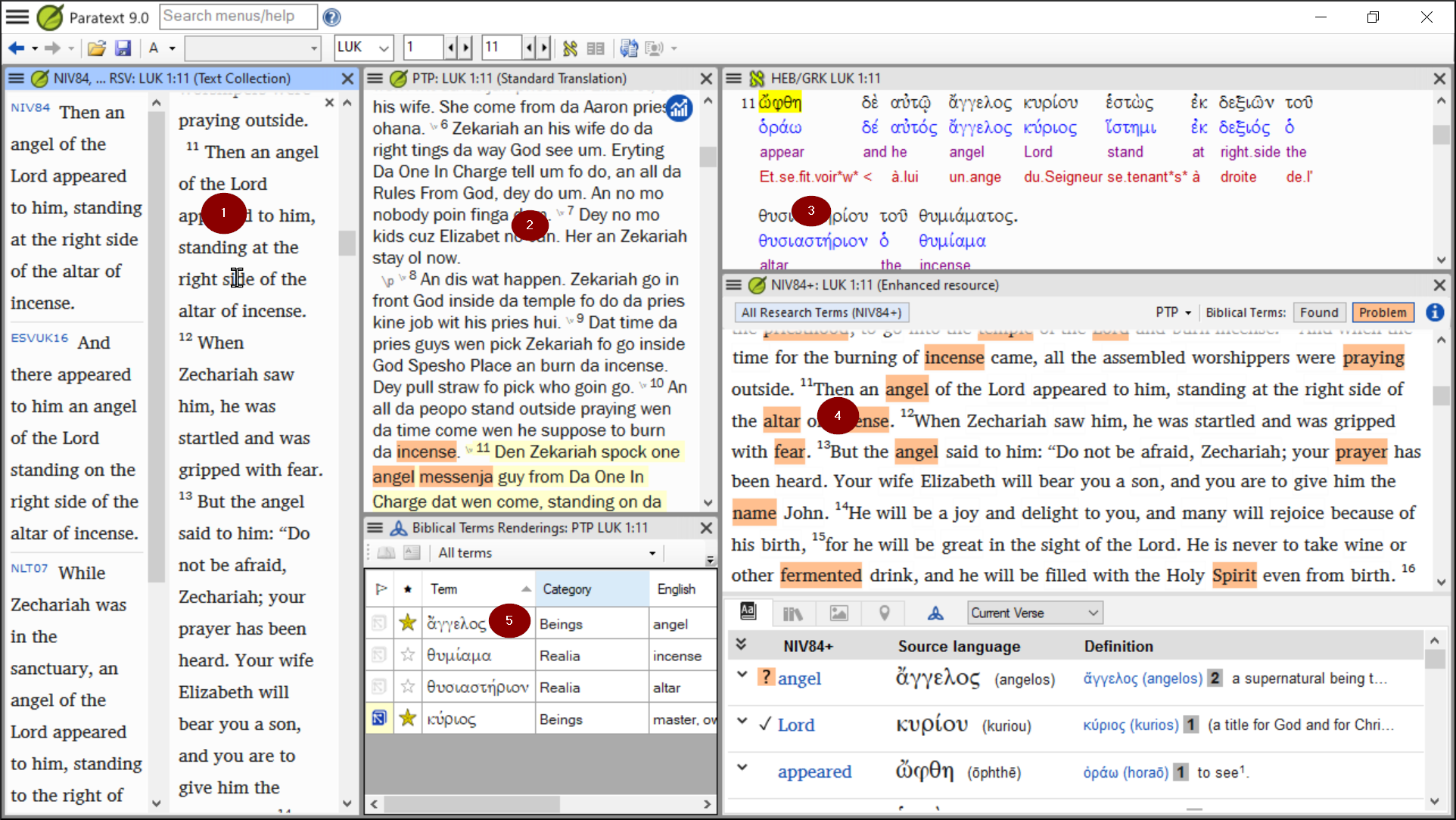
- Your screen should look something like the picture below (if not, see below).
2.3 Create a new text layout
If you haven’t already saved a layout, then we recommend you do the following:
Open and arrange the windows
- Open 5 windows as follows:
- 1= Text collection
- ≡ Paratext menu, under Paratext choose Open Text Collection, select several resources, click Right arrow button, click OK. See 2.5)
- 2 = Your project
- ≡ Paratext menu under Paratext > Open, ≡ Projects
- 5 = Renderings
- ≡ Tab menu, under Tools > Biblical Terms renderings
- 3 = Source text
- ≡ Paratext menu, under Paratext > Open > Source language text
- 4 = Enhanced resource
- ≡ Paratext menu, under Paratext > Open > Enhanced resources
- Arrange the windows as desired. See Paratext video 0.2.1b, 0.2.1c, and 0.2.1d.
In Paratext 9.3 (and above) you can use the main Paratext menu to arrange windows by rows and columns.
Remember to save your layout!
Save the layout
Once the windows are arranged as desired:
- ≡ Paratext, under Layout > Save current layout
- Type a new name
- OR to replace an existing layout,
- Click the dropdown list to the right 2, Choose the existing name of saved layout
- Click OK
2.4 Delete a text layout
If you want to delete a saved layout,
- ≡ Paratext menu, under Layout > Delete layout
- Click the dropdown to the right
- Choose the name of the saved layout.
- Click Delete
2.5 Open resources in a Text collection
With Paratext, it is possible to have several project/resources open at the same time. However, rather than having too many windows, it is better to have several texts in one window.
In Paratext 9.3 the Text Collection can also be opened directly from the ≡ Paratext menu
New method - Open directly from Paratext menu
- ≡ Paratext menu, under Paratext > Open text collection

- Select several resources using the Ctrl key as you click on the resource.
- Click on the Right arrow button.
- The resources are listed in the Selected column.
- Repeat as necessary.
- Use the up and down arrows to reorder them as needed.
Save the collection
- Click in the text box in the bottom left corner.
- Type a name for the saved collection and click the save icon
- Click OK.
- The text collection opens.
Previous method - Open dialog
- ≡ Paratext menu, under Paratext > Open
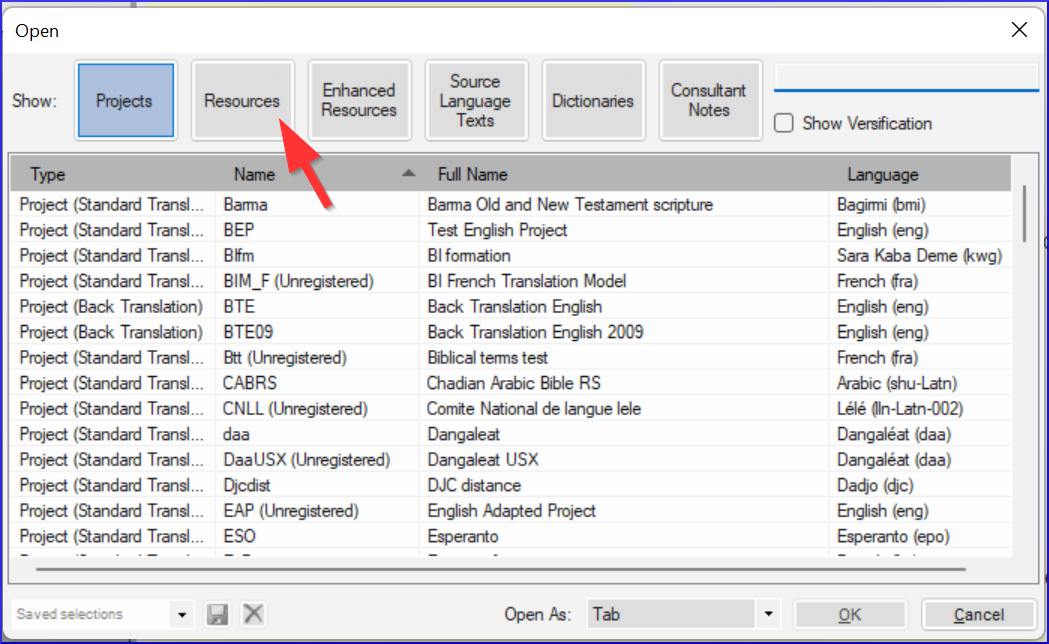
- Click on the Resources button (at the top).
- Select several resources using the Ctrl key as you click on the resource.
- Repeat as necessary.
- Click on the Open as dropdown list.
- Choose Text collection panel
- Click OK
It is suggested that resources be displayed in the order of more literal to less literal (to focus on the texts that are most faithful to the source texts). For English resources: ESV, RSV, NIV, NLT. For French resources, the following order is suggested: TOB, NVSR78Col, NBS, BDS, FC97, PDV11.
There are several ways to change the order of texts in the collection. One way is to use the menu.
- ≡ Tab, Modify text collection

- Use the arrow buttons to change the order as necessary
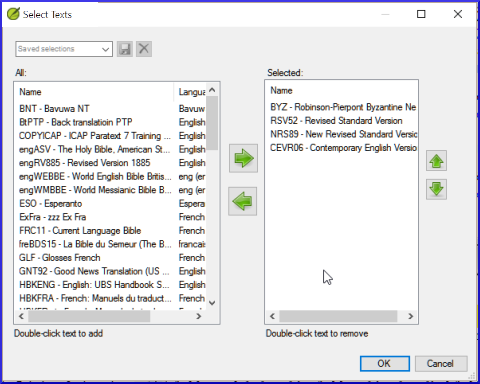
- Make any other changes
- Click OK
Another way is to right-click a text.
You can change the text in the second pane by clicking on the blue link of the abbreviation for the text. You can also use the view menu (≡ Tab under View menu, choose preview, unformatted or standard).
2.6 Open an Enhanced Resource
- ≡ Paratext menu, under Paratext > Open
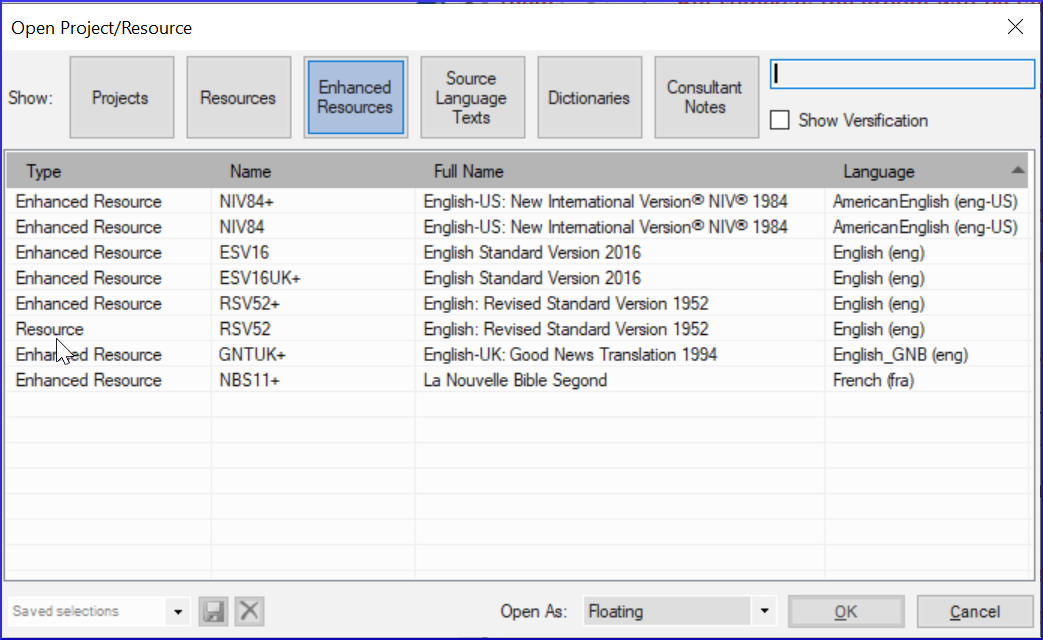
- Click on Enhanced Resources
Enhanced resources also contain a dictionary, images, maps etc. When you open an Enhanced Resource, a guide opens as well.
2.7 Open a dictionary
If you do not use an enhanced resource, you can open a source language dictionary with glosses in other languages.
- ≡ Paratext menu, under Paratext > Open
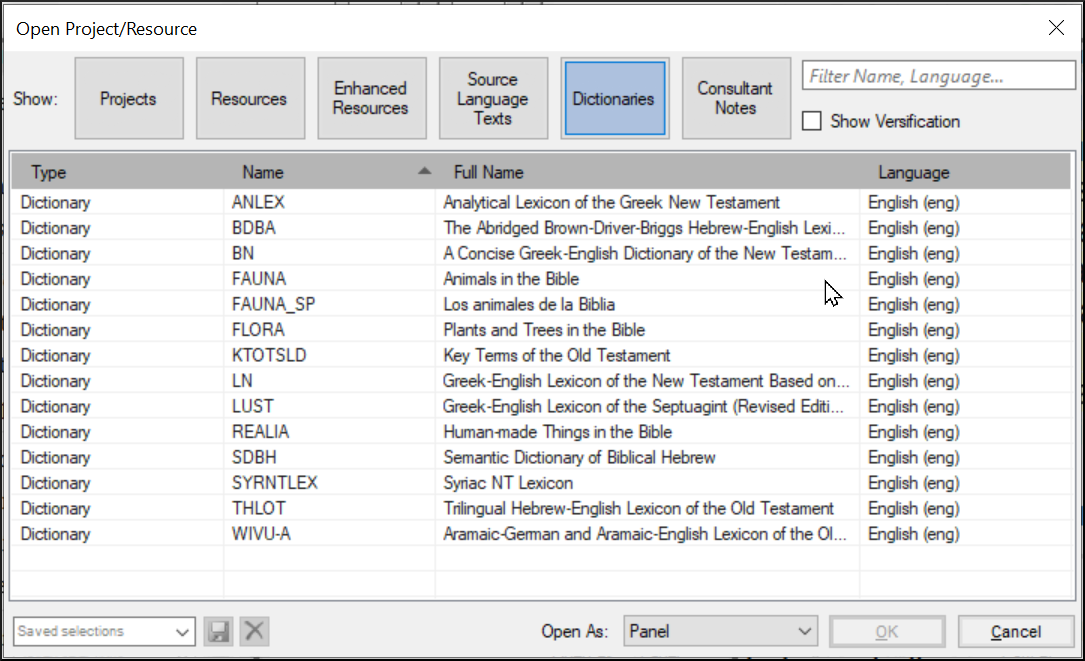
- Click Dictionaries
- Choose “A Concise Greek-English Dictionary of the New Testament” OR “Trilingual Hebrew-English Lexicon of the Old Testament”
- Click OK
- View > choose a language (e.g. French)
It is useful to add dictionary windows to the autohide, (right-click on the tab name, choose move to autohide).
Other dictionaries (in English but with photos)
- "Plants and Trees in the Bible"
- "Animals in the Bible"
2.8 Working with the Source language text
You can open the source language text with glosses in an alternative language than English, e.g. French.
- ≡ Paratext, under Paratext > Open

- Click Source Language Texts
- Choose HEB/GRK
- Click OK
If you have downloaded the special gloss resource, you can load them
- ≡ Tab under View > Additional glosses
- Choose the resource which has the glosses (e.g. GlossFR)
- Click OK